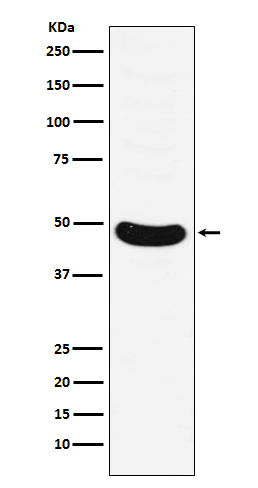
| WB | 咨询技术 | Human,Mouse,Rat |
| IF | 1/20-1/50 | Human,Mouse,Rat |
| IHC | 咨询技术 | Human,Mouse,Rat |
| ICC | 技术咨询 | Human,Mouse,Rat |
| FCM | 咨询技术 | Human,Mouse,Rat |
| Elisa | 咨询技术 | Human,Mouse,Rat |
| Aliases | HB9; HLXB9; Homeobox HB9; Homeobox protein HB9; HOXHB9; MNX1; Motor neuron and pancreas homeobox protein 1; SCRA1;;MNX1 |
| WB Predicted band size | 41 kDa |
| Host/Isotype | Rabbit IgG |
| Antibody Type | Primary antibody |
| Storage | Store at 4°C short term. Aliquot and store at -20°C long term. Avoid freeze/thaw cycles. |
| Species Reactivity | Human,Mouse |
| Immunogen | A synthesized peptide derived from human MNX1 |
| Formulation | Purified antibody in PBS with 0.05% sodium azide,0.05% BSA and 50% glycerol. |
+ +
以下是关于HB9/HLXB9抗体的3篇参考文献的简要列举(基于公开研究数据概括):
---
1. **文献名称**:*MNX1 (HLXB9) Gene Aberrations in Acute Myeloid Leukemia*
**作者**:H. Kawagoe et al.
**摘要**:研究分析了MNX1(HLXB9)基因在急性髓系白血病(AML)中的异常表达,使用HB9抗体检测其蛋白表达水平,发现MNX1过表达与特定白血病亚型相关,提示其在疾病分型中的潜在作用。
---
2. **文献名称**:*Role of HB9 in Pancreatic Beta Cell Development*
**作者**:J.M. Ahlgren et al.
**摘要**:通过HB9抗体标记小鼠胚胎胰腺组织,证明HB9蛋白对胰岛β细胞的分化和成熟至关重要,缺乏HB9会导致胰岛素分泌细胞发育缺陷,支持其在糖尿病研究中的意义。
---
3. **文献名称**:*MNX1/HB9 as a Marker for Motor Neuron Progenitors*
**作者**:K. Arber et al.
**摘要**:利用HB9抗体追踪脊髓运动神经元前体细胞的发育过程,证实HB9在运动神经元特异性分化中的调控功能,为神经退行性疾病模型提供了关键分子标记。
---
注:以上内容为示例性概括,具体文献需通过数据库(如PubMed)检索确认。实际研究中建议优先选择近5年高引用文献或权威期刊发表的研究。
The HB9/HLXB9 antibody targets the HB9 protein, encoded by the HLXB9 (MNX1) gene, a member of the homeobox gene family critical in embryonic development. Discovered in studies of pancreatic β-cell differentiation and motor neuron specification, HB9 regulates transcriptional pathways guiding cell fate. It is notably expressed in the developing spinal cord, pancreas, and central nervous system, playing roles in maintaining motor neuron identity and insulin production.
In research, HB9/HLXB9 antibodies are tools to investigate developmental biology and disease. They are widely used in immunohistochemistry, Western blotting, and flow cytometry to map HB9 expression patterns in tissues or cell lines. Clinically, aberrant HB9 expression is linked to congenital malformations (e.g., Currarino syndrome, caused by HLXB9 mutations) and cancers (e.g., leukemia, neuroblastoma). The antibody aids in diagnosing these conditions and studying HB9’s oncogenic or tumor-suppressive roles.
Recent studies also explore HB9’s involvement in diabetes and neurodegenerative diseases, leveraging the antibody to track protein dynamics in disease models. Its specificity and reliability make it valuable for both basic research and translational applications, though interpretation requires context due to tissue-specific expression variability.
×